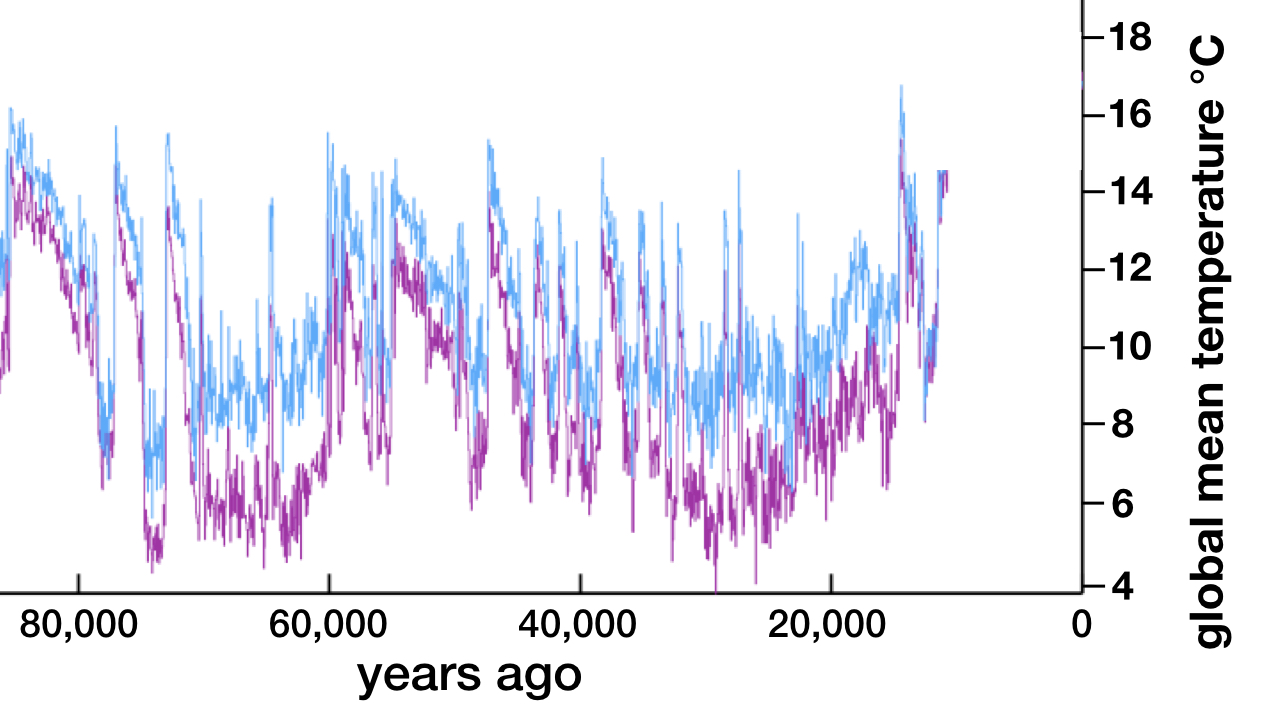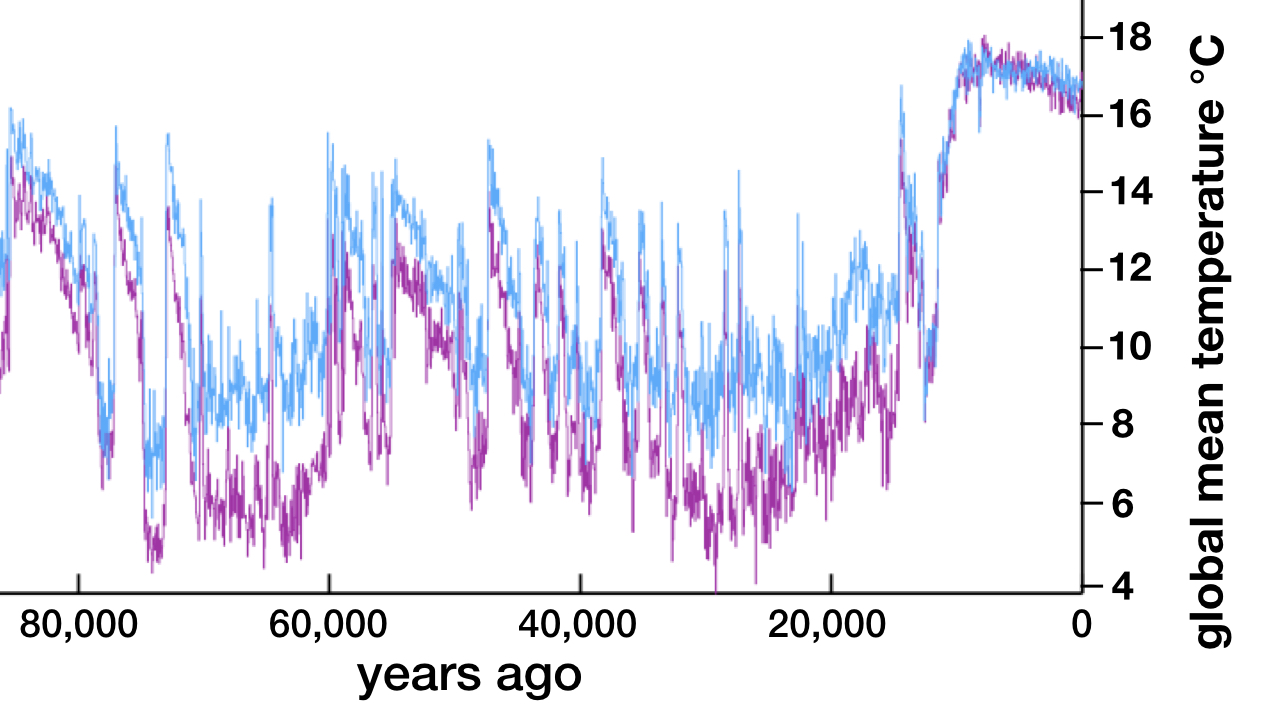Present Climate Epoch Has Been Extremely Stable
One of the most outstanding and blessed features of Earth is that it has an ice age cycle where, for the past 9,000 years of that cycle, the planet has experienced extreme climate stability. New analysis of historical temperature measurements garnered from 73 different locations on Earth now reveals that the climate of the past 9,000 years has been far more stable than previously thought. That is, we humans are much more blessed than we previously recognized.
As I have explained in chapter 15 of my book, Improbable Planet, an ice age cycle where Earth’s surface ice coverage oscillates between 10 and 20–23 percent is an essential requirement for billions of humans to live on Earth at one time.1 It is also critical that the period of oscillation be roughly 100,000 years.
An ice age cycle has existed on Earth for only the last 1/1,754th part of its history. And Earth’s ice age cycle has had a period of roughly 100,000 years for only the last 1/5,882nd part of its history.
Scientists have uncovered a long list of different phenomena that each play a role in sustaining the ice age cycle. I have described some of these phenomena in Improbable Planet2 and many more in a series of three blogs that were posted on October 1,3 October 8,4and October 155, respectively.
Past Climate Stability Determinations
These phenomena all impact the ice age cycle in different ways. Hence, the ice age cycle is characterized by extreme climate instability. Figure 1 shows the variation in the global mean temperature that persisted previous to 9,000 years ago as determined by oxygen-18 isotope abundances (excellent proxies for temperature) in two high-altitude Greenland ice cores. The indicated global mean temperature had fluctuated by as much as 10°C (18°F) on timescales of a few centuries or less.

Figure 1: Global mean temperature variations previous to 9,000 years ago. The blue and purple traces mark the global mean temperatures as recorded in the Greenland NGRIP and GRIP ice cores respectively. Data credit: NGRIP and GRIP; Diagram credit: Hugh Ross
This extreme climate instability was a feature throughout the ice age cycle with the exception of the past 9,000 years. Figure 2 displays temperature measures from the two high-altitude Greenland ice cores. The graph reveals that the global mean temperature stabilized 9,000 years ago and has remained stable since that time. It shows that the global mean temperature did not vary by more than ±1.25°C over the past 9,000 years.

Figure 2: Transition from extreme climate instability to extreme climate stability. The graph shows the global mean temperatures deduced from the Greenland NGRIP (blue trace) and GRIP (purple trace) ice cores. Data credit: NGRIP and GRIP; Diagram credit: Hugh Ross
Due to extreme climate instability, humans struggled to launch civilization previous to 10,000 years ago and they were limited to small-scale mixed agriculture and bakery production (see my July 26, 2016 blog6 and my August 27, 2018 blog7). It was the advent of extreme climate stability that was primarily responsible for the technical and cultural big bang known as the Neolithic Revolution.
Recent Climate Stability Determinations
A team of four Earth scientists at Oregon State University and Harvard University led by Shaun Marcott noted that the past climate record as determined by measurements from deep Greenland ice cores did not adequately account for the effect of altitude on climate.8They reconstructed regional and global temperatures for the past 11,300 years from 73 globally distributed records. These 73 records were based on a variety of paleotemperature proxies, not just oxygen-18 isotope measures. Marcott and his associates accounted for chronological and proxy calibration uncertainties with Monte Carlo computational algorithms based on 1,000 realizations.
The team’s reconstruction revealed that the global mean climate was more stable than what the high-altitude Greenland ice core measurements indicated. Like these Greenland ice cores, though, they showed a gradual, long-term cooling trend from a little more than 5,000 years ago until 1950 AD.
Statistician Grant Foster9 and petrophysicist Andy May10 argued that not all of the Marcott team’s 73 proxies can be counted on to deliver reliable measurements of past global temperatures. May commented that “some are affected by local conditions that have no regional or global significance; others cover short time spans that do not cover the two most important climatic features of the Holocene, the Little Ice Age and the Holocene Climatic Optimum [Medieval Warm Period].”11
May performed a temperature reconstruction of the Holocene epoch (11,650 years ago to the present) using the 29 most reliable proxies in the Marcott group’s database. Nine of these proxies were from 60°N–90°N latitude, seven from 30°N–60°N latitude, seven from 30°S–30°N latitude, three from 60°S–30°S latitude, and three from 90°S–60°S latitude. Figure 3 shows May’s temperature history for the Holocene epoch. I added the near vertical line to the extreme left of May’s plot to show the rise in the global mean temperature since 1950.

Figure 3: Reconstruction of the global mean temperature over the past 11,300 years. Temperature measurements are in degrees C. Data credit: Marcott et al. and Andy May; Diagram credit: Hugh Ross
Figure 3 shows that the global mean temperature did not vary by more than ±0.65°C over the past 9,000 years. That is, the global climate over the past 9,000 years was twice as stable as what the high-altitude Greenland ice cores (figure 2) had indicated. May’s reconstruction affirmed a gradual, long-term cooling trend from 8,000 to 70 years ago but only to half the degree that was indicated in the Greenland ice cores.
A cause for some concern is that all the cooling that has occurred from 8,000 to 70 years ago has been entirely reversed in just the past 70 years. However, a reason to express yet more gratefulness to our Creator is that the past 9,000 years of climate stability is much more stable than what scientists had previously thought. The gift of extreme climate stability, thus, is much more valuable than what scientists had previously measured, especially when that value is measured against the extreme climate instability that characterizes the ice age cycle.
We indeed have much to be thankful for. As for the past 70 years of rapid temperature rise, we need to acknowledge that most of that rise is due to our mismanagement of Earth’s resources. That mismanagement should motivate us to go to our Creator for the wisdom, humility, and grace we lack to fulfill the mandate God gave us to manage Earth’s resources for our benefit and for the benefit of all Earth’s life.
In next week’s blog, I will describe how a recently discovered collision event helps explain why we have enjoyed such an extremely stable climate for the past 9,000 years.
Featured image: Terraced rice fields in China exemplify intensive cultivation made possible by our present epoch of extreme climate stability. Image credit: Jialiang Gao, www.peace-on-earth.org.
Check out more from Reasons to Believe @Reasons.org
Endnotes
- Hugh Ross, Improbable Planet: How Earth Became Humanity’s Home (Grand Rapids, MI: Baker, 2016): 198–219.
- Ross, Improbable Planet, 200–08.
- Hugh Ross, “Miracles of the Mid-Pleistocene Transition, Part 1,” Today’s New Reason to Believe (blog), Reasons to Believe, October 1, 2018, https://www.reasons.org/explore/blogs/todays-new-reason-to-believe/read/todays-new-reason-to-believe/2018/10/01/miracles-of-the-mid-pleistocene-transition-part-1.
- Hugh Ross, “Miracles of the Mid-Pleistocene Transition, Part 2,” Today’s New Reason to Believe (blog), Reasons to Believe, October 8, 2018, https://www.reasons.org/explore/blogs/todays-new-reason-to-believe/read/todays-new-reason-to-believe/2018/10/08/miracles-of-the-mid-pleistocene-transition-part-2.
- Hugh Ross, “Miracles of the Mid-Pleistocene Transition, Part 3,” Today’s New Reason to Believe (blog), Reasons to Believe, October 15, 2018, https://www.reasons.org/explore/blogs/todays-new-reason-to-believe/read/todays-new-reason-to-believe/2018/10/15/miracles-of-the-mid-pleistocene-transition-part-3.
- Hugh Ross, “Farming Revolution Simultaneously Launches in Multiple Locations,” Today’s New Reason to Believe (blog), Reasons to Believe, July 26, 2016, https://www.reasons.org/explore/blogs/todays-new-reason-to-believe/read/todays-new-reason-to-believe/2016/07/26/farming-revolution-simultaneously-launches-in-multiple-locations.
- Hugh Ross, “Confirmation that Early Humans Were Making Bread,” Today’s New Reason to Believe (blog), Reasons to Believe, August 27, 2018, https://www.reasons.org/explore/blogs/todays-new-reason-to-believe/read/todays-new-reason-to-believe/2018/08/27/confirmation-that-early-humans-were-making-bread.
- Shaun A. Marcott et al., “A Reconstruction of Regional and Global Temperature for the Past 11,300 Years,” Science 339 (March 8, 2013): 1198–1201, doi:10.1126/science.1228026.
- Grant Foster, “The Tick,” Open Mind (blog), March 22, 2013, https://tamino.wordpress.com/2013/03/22/the-tick/.
- Andy May, “A Holocene Temperature Reconstruction Part 4: The Global Reconstruction,” Watts Up With That? (blog), June 9, 2017, https://wattsupwiththat.com/2017/06/09/a-holocene-temperature-reconstruction-part-4-the-global-reconstruction/.
- May, “A Holocene Temperature Reconstruction,” p. 7.



